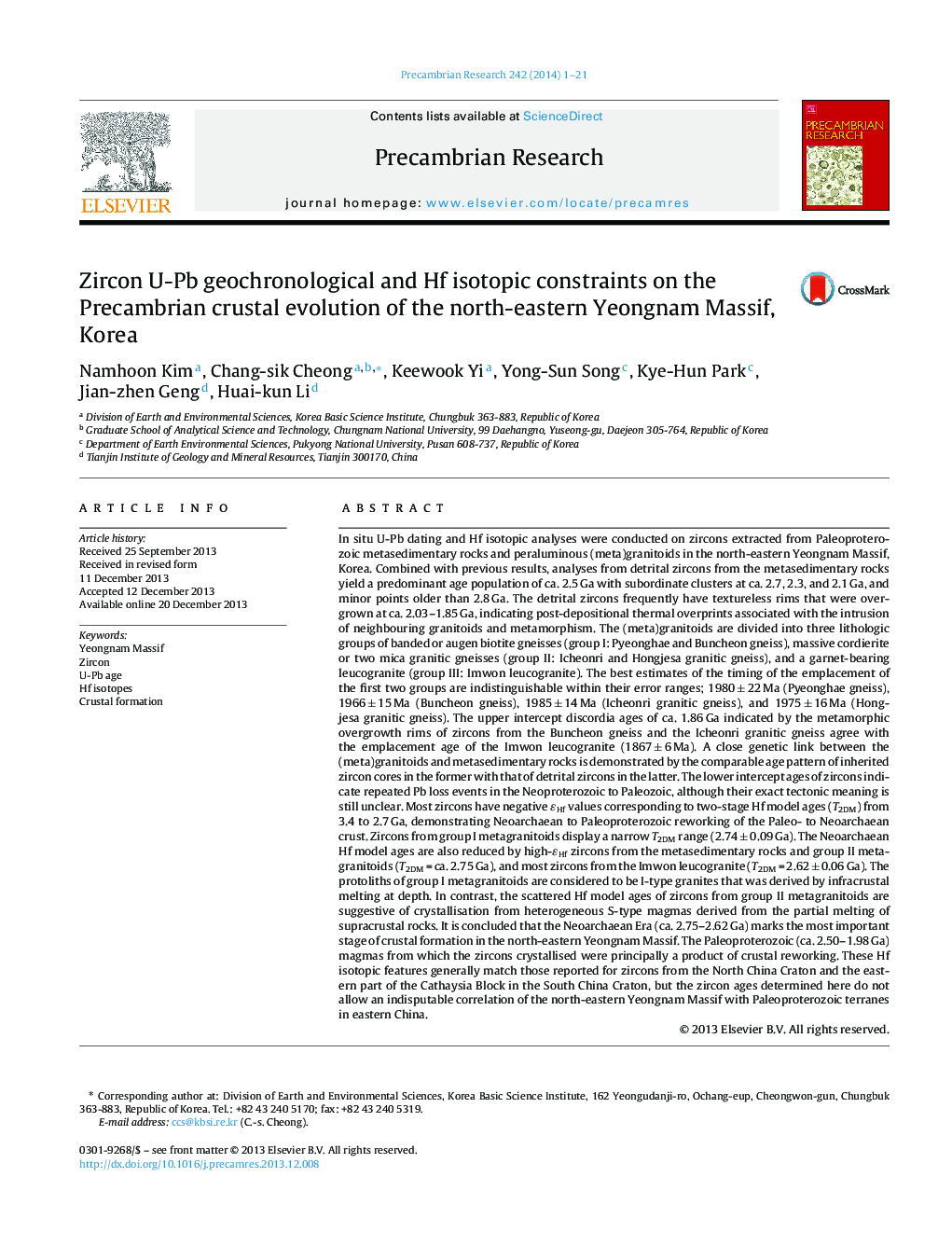| کد مقاله | کد نشریه | سال انتشار | مقاله انگلیسی | نسخه تمام متن |
|---|---|---|---|---|
| 4723076 | 1639632 | 2014 | 21 صفحه PDF | دانلود رایگان |

• We analysed zircons from the north-eastern Yeongnam Massif, Korea.
• Detrital and inherited zircons showed comparable Archaean–Proterozoic age populations.
• Zircon U-Pb dating established the magmatism and metamorphism at ca. 1.98 and 1.86 Ga.
• Neoproterozoic to Paleozoic Pb loss events were indicated by the zircons.
• Zircon Hf isotopes indicated a juvenile crustal formation at ca. 2.7 Ga.
In situ U-Pb dating and Hf isotopic analyses were conducted on zircons extracted from Paleoproterozoic metasedimentary rocks and peraluminous (meta)granitoids in the north-eastern Yeongnam Massif, Korea. Combined with previous results, analyses from detrital zircons from the metasedimentary rocks yield a predominant age population of ca. 2.5 Ga with subordinate clusters at ca. 2.7, 2.3, and 2.1 Ga, and minor points older than 2.8 Ga. The detrital zircons frequently have textureless rims that were overgrown at ca. 2.03–1.85 Ga, indicating post-depositional thermal overprints associated with the intrusion of neighbouring granitoids and metamorphism. The (meta)granitoids are divided into three lithologic groups of banded or augen biotite gneisses (group I: Pyeonghae and Buncheon gneiss), massive cordierite or two mica granitic gneisses (group II: Icheonri and Hongjesa granitic gneiss), and a garnet-bearing leucogranite (group III: Imwon leucogranite). The best estimates of the timing of the emplacement of the first two groups are indistinguishable within their error ranges; 1980 ± 22 Ma (Pyeonghae gneiss), 1966 ± 15 Ma (Buncheon gneiss), 1985 ± 14 Ma (Icheonri granitic gneiss), and 1975 ± 16 Ma (Hongjesa granitic gneiss). The upper intercept discordia ages of ca. 1.86 Ga indicated by the metamorphic overgrowth rims of zircons from the Buncheon gneiss and the Icheonri granitic gneiss agree with the emplacement age of the Imwon leucogranite (1867 ± 6 Ma). A close genetic link between the (meta)granitoids and metasedimentary rocks is demonstrated by the comparable age pattern of inherited zircon cores in the former with that of detrital zircons in the latter. The lower intercept ages of zircons indicate repeated Pb loss events in the Neoproterozoic to Paleozoic, although their exact tectonic meaning is still unclear. Most zircons have negative ɛHf values corresponding to two-stage Hf model ages (T2DM) from 3.4 to 2.7 Ga, demonstrating Neoarchaean to Paleoproterozoic reworking of the Paleo- to Neoarchaean crust. Zircons from group I metagranitoids display a narrow T2DM range (2.74 ± 0.09 Ga). The Neoarchaean Hf model ages are also reduced by high-ɛHf zircons from the metasedimentary rocks and group II metagranitoids (T2DM = ca. 2.75 Ga), and most zircons from the Imwon leucogranite (T2DM = 2.62 ± 0.06 Ga). The protoliths of group I metagranitoids are considered to be I-type granites that was derived by infracrustal melting at depth. In contrast, the scattered Hf model ages of zircons from group II metagranitoids are suggestive of crystallisation from heterogeneous S-type magmas derived from the partial melting of supracrustal rocks. It is concluded that the Neoarchaean Era (ca. 2.75–2.62 Ga) marks the most important stage of crustal formation in the north-eastern Yeongnam Massif. The Paleoproterozoic (ca. 2.50–1.98 Ga) magmas from which the zircons crystallised were principally a product of crustal reworking. These Hf isotopic features generally match those reported for zircons from the North China Craton and the eastern part of the Cathaysia Block in the South China Craton, but the zircon ages determined here do not allow an indisputable correlation of the north-eastern Yeongnam Massif with Paleoproterozoic terranes in eastern China.
Journal: Precambrian Research - Volume 242, March 2014, Pages 1–21